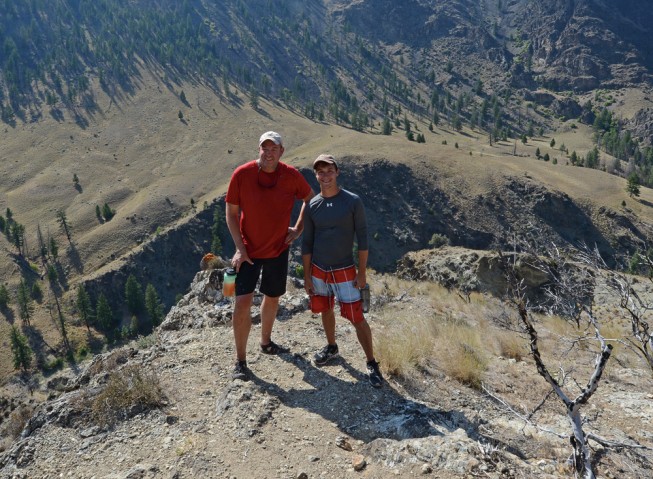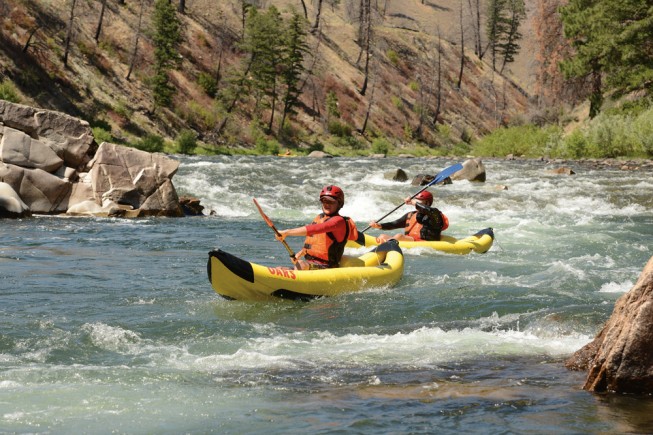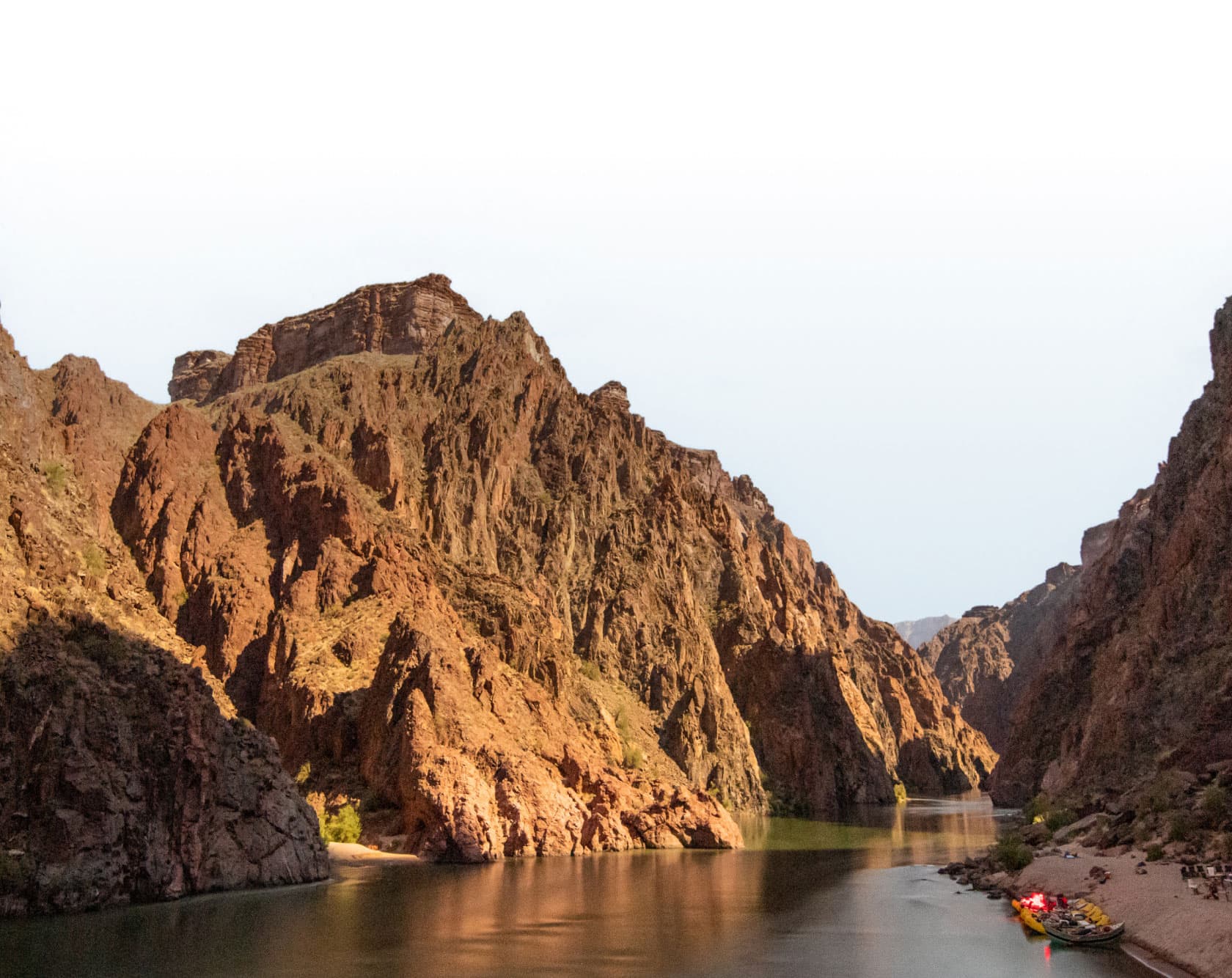An Eye-Opening Father-Son Trip on the Salmon River


How the Ever-Changing River Changes Us
There’s a precise moment in most families when the parent and child’s roles reverse, when the formerly protected child becomes the guardian for his parent.
“It was the proudest moment I’ve had as a parent thus far,” recalls Monte Rector who, along with son Matthew, embarked on a six-day father-son trip on the Middle Fork of the Salmon River in the Frank Church “River of No Return” Wilderness. “It was our very first night on the river. Matthew and I’d decided to hike to the top of the ridgeline. We’d assumed we could just follow the game trail, but the ground gave way to broken rock as we went higher and passage become more precarious, especially for a couple of guys from Texas.”

Monte and Matt, ages fifty-four and twenty-one respectively, remained determined to hike above the “State Land Right” campsite to the summit, a cross-face, non-technical climb that required confident footing. And then, suddenly, that moment occurred. “It wasn’t so much spoken as understood,” Matt explains, “I’d been leading but I realized I should let my father set the pace. I figured if I was feeling a little uncomfortable about the angle, my dad must be also. My awareness of his steps and balance merged with my observations of the incredible landscape.”
“There was a definite role reversal when he slipped behind me to watch for any missteps,” continues Monte, who has camped with Matt since he was a toddler. “I remember when it happened with my father and now it had happened with me. My friends laugh at me, but this is the story that I’ve told more often than any other from the river.”
A natural storyteller, Monte had plenty of other tales to share. The Rectors had come off the OARS waitlist just one week before the launch date. They’d requested the Grand Canyon but eagerly seized the opportunity to explore Idaho for the first time. Whitewater newbies, the father-son duo had never paddled a kayak either, let alone upon a wild Class III and IV river that descends thirty feet per mile via 100 rated rapids.
At put-in, the “roll test”—when potential kayakers demonstrate their ability to remount the sit-on-top inflatable kayaks in a timely manner—foreshadowed the pair’s evolving roles. Faced with this test in front of a gallery of strangers, Matt, a college athlete, naturally raised his hand to go first. Monte, who had played college basketball several decades earlier, felt much more tentative.

“I’ll remember the kayak trial for the rest of my life,” laughs Monte. “I’m a 6’5”, 240-pound guy, so I was quite nervous about how to get back in cleanly. But I did it and have to say, the thrill of whitewater kayaking with my son is something else I’ll never forget.”
Monte and Matt were first in the inflatable kayaks at the Indian Creek launch, working through the Marble Creek Rapids, a river-wide drop that can quickly swamp a kayak. The duo sailed through, though the guide assessments were clear when the afternoon’s kayakers were selected for the more challenging Tappan Falls.
“Matthew and I rode the kayaks in the morning, but a guide quietly suggested that I sit out the afternoon’s rapids,” explained Monte. “Matthew’s first instinct was to skip it also and jump in a raft with his dad, but I know my son, and I encouraged him to run those rapids.”
Matt became the ace kayaker of the trip, encouraged by the guides to run the most intimidating whitewater, including the multi-layered, Class IV Haystack Rapids. His favorite memories on their father-son trip, however, remain paddling side-by-side with his dad.

“You get to tailor the kayak’s direction so you’re not at the mercy of the big group,” Matt says. “We could go see curious landmarks, plus we had a lot more time to appreciate what we were doing and maintain a conversation throughout the day. It was a time for both of us to just be together.”
A multi-day, whitewater rafting trip is hardly an isolated affair, however. The Rector men became popular members of the 25-person gathering. Monte for his wise and positive observations delivered in a syrupy drawl indicative of his Louisiana upbringing, and Matt for his unbridled enthusiasm coupled with a budding biologist’s interest in digesting as much as possible about the environment.
“I’ve taken safaris, fishing junkets and many tours,” Monte explained, “But I was impressed with the quality of the people and frankly amazed by the sustained passion of the guides. Professionally, I’ve never seen anything like the attention Matt, who is allergic to bees, received when he was stung that last morning. On a lighter note, Matt and I are serious foodies, and we had friends tell us we’d be astounded by the quality of the meals. They were right.”
“We considered this an adventure, because we really didn’t know what to expect,” continues Matt, who spoke with me having just returned from fieldwork collecting arachnids in the Arizona desert. He cited his father-son trip on the Salmon River for fueling his desire to camp in the southwestern wilderness.

“I didn’t realize it was possible to have such freedom on a river. I was also impressed that the guides were there not simply to be rafting coaches, but to teach us about the biodiversity, geology and cultural history of the region.”
Though Matt asked more natural history questions than anyone, he also cherished membership in “the beer and nipple club,” a group that assembled each afternoon to stand chest high in the chilly river and down a beer.
Monte would eagerly await lead guide Bill “Bronco” Bruchak’s summary of each day’s voyage, a colorful catalog of every rapid, seasoned with anecdotes from the present assembly and tales of natural and cultural history. After Bronco finished and the sun had set, Monte would visit around the fire circle for a while before departing because he was tired, but also to give Matthew some room to be on his own.
“We began this adventure as father and son,” concludes Monte, “but we came off the river as peers.”
Related Posts
Sign up for Our Newsletter





